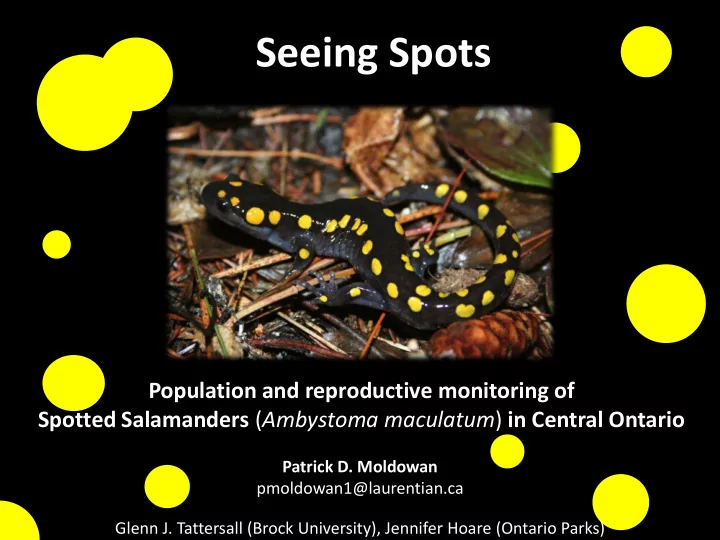

Seeing Spots Population and reproductive monitoring of Spotted Salamanders ( Ambystoma maculatum ) in Central Ontario Patrick D. Moldowan pmoldowan1@laurentian.ca Glenn J. Tattersall (Brock University), Jennifer Hoare (Ontario Parks)
Field site Bat Lake, Algonquin Provincial Park
BLISS Background Bat Lake • Spruce bog • 1 hectare area (~2.5 acres) • Naturally fishless • Stable pH 4.2 • Breeding site for 8 amphibian sp. • Adjacent to the Algonquin Wildlife Research Station
Life in the acid vat • Ambystoma maculatum embryos intolerant of acidic conditions (Pierce 1985) • Reportedly 100% mortality at pH G. Tattersall G. Tattersall 4.0-5.0 and 50% mortality between 5.0-7.0 (Pough and Wilson 1977, Cook 1983) . . . but Bat Lake has a reproducing population at pH 4.2 . . . Glenn Tattersall Matt Keevil
Blue-spotted salamander ( A. laterale )
Research objectives 1) Monitor the arrival and departure dates of Ambystoma maculatum at their breeding environment 2) Estimate the population size and operational sex ratio of salamanders at Bat Lake 3) Determine the local pond use patterns and map migration corridors to the lake 4) Determine the total egg mass deposition in Bat Lake 5) Monitor morphological parameters of adult spotted salamanders 6) Monitor year-to-year variation in the above parameters and establish a database for future ecological, physiological or conservation studies .
Research methods
Objective 1 Migration phenology 35 No. males captured 30 No. of captures No. females captured 25 20 15 10 5 0 115 119 123 127 131 135 Julian date
Skeletochronology Sean Boyle
Skeletochronology Female 18 Male Number of Individuals 16 14 12 10 Sean Boyle 8 6 4 2 0 1 2 3 4 5 6 7 8 9 10 11 12 13 Number of LAGs
Objective 2 Breeding demographics 6 Sex ratio ( ♂ : ♀ ) 5 4 3 2 1 0 2008 2009 2010 2011 2012 2013 Year
Objective 2 Breeding demographics 450 Malecaptures 400 Female captures Capture number 350 300 250 200 150 100 50 0 2008 2009 2010 2011 2012 2013 Year
Objective 2 Population estimates Population estimates 7000 6000 5000 4000 3000 2000 1000 0 2009 2010 2011 2012 Year
Objective 3 Migration corridors G. Tattersall
Objective 4 Annual egg lay phenology 2500 No. of egg masses 2000 1500 1000 500 0 105 115 125 135 Breeding season (Julian date)
Objective 4 Egg lay phenology slope = -0.82 days per year 130 Date of first egg laying May 6 125 April 30 May 2 (Julian date) 120 April 30 April 30 April 27 115 April 25 April 25 April 23 110 105 April 14 100 April 7 95 90 1992 1996 2000 2004 2008 2012 Year y = -0.8166x + 1752.2, R² = 0.4284
Spot “fingerprint”
2011 recapture 2008 capture
2011 recapture 2008 capture
I 3 S software applications • Spot patterns • Skin features ( e.g. , warts) Future work • I 3 S Manta (spot shape and size) • I 3 S Contour (tracing)
Publications
Summary findings • Since 2008, 1540 A. maculatum ( N male =1168, N female =372) have been uniquely identified in the Bat Lake population • Annual recapture rate ~20% • Breeding population estimates: 3435 ± 1514 • Annual data collection on: morphometrics, sex ratio, breeding and egg laying phenology, population dynamics, lake usage patterns, migration routes, and rate of injury and deformity, etc
Acknowledgments For their dedication and many contributions to BLISS Glenn Tattersall , David LeGros , Sean Boyle , Steven Kell and Olivia Butty For logistical support Algonquin Wildlife Research Station, Rory Eckenswiller, Jennifer Hoare, and Brad Steinberg For monetary and in-kind support I thank the below groups:
Questions and comments?
Objective 1 Breeding season duration 150 May 19 May 17 140 Julian date Julian date 130 April 22 26 18 120 20 28 21 110 April 9 100 42 90 2008 2009 2010 2011 2012 2013 Year
Recommend
More recommend